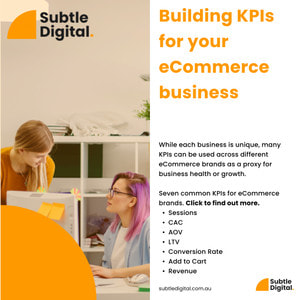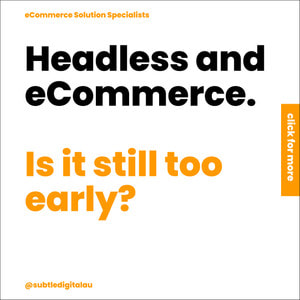Table Of Contents
- 1. What is a KPI and why do I need them?
- 2. The best seven KPIs for eCommerce growth?
- 2.1 Sessions
- 2.2 CAC
- 2.3 AOV
- 2.4 Life Time Value (LTV)
- 2.5 Conversion Rate
- 2.6 Add to Cart Rate
- 2.7 Revenue
- 3. In conclusion
What is a KPI and why do I need them?
A KPI (Key Performance Indicator) is a target set to measure success for projects, teams and business units. KPIs can be unique to a business or pulled from common sets of business goals and or objectives. For example, a KPI of channel effectiveness is CAC (customer acquisition cost). CAC is a proxy for how much it costs to acquire a customer (via the channel). If the business spent $5,000 on paid media and acquired 50 new clients, the CAC cost would be $100 per customer.
While CAC doesn’t mean a lot in isolation, when it’s coupled with another metric AOV (average order value) it's a valuable KPI to determine whether the cost of acquiring a customer through a channel is an effective use of money/resources – it may mean that you need to optimise/change your paid media ads, investigate the customer journey for any issues or look into your current pricing strategy or product mix.
Think of a KPI as a proxy for success.
The best seven KPIs for eCommerce growth
While each business is unique, many KPIs can be used across different eCommerce brands as a proxy for business health or growth. Below is a list of seven common KPIs for eCommerce brands and why you should be using them.
Sessions
- On a monthly basis it’s a good idea to measure how you’re tracking from month to month. This can help you understand:
- Whether a particular channel is driving more growth - do you need to put more effort into that channel?
- What channels aren’t performing? – Is there a gap here that you need to address?
- What is the average time each channel spends on your site? - Do users from Facebook spend more time on average on site? Can you leverage this?
- How are your users split? Mobile or desktop? Is there a way we can make the site more friendly for mobile users if a large % is from this group.
CAC
- CAC is explained above. The TL; DR version – how much money it costs to acquire a new customer vs ad spend. CAC is really important as it allows you to understand the efficiency of a particular channel vs the spend/effort you are placing into paid efforts.
- For new brands working across multiple paid channels, it’s important to group the efforts together with a blended CAC. This is due to attribution issues; this means that a user may come from Facebook initially but end up clicking on a Google Ad link and purchasing a product. While Google gets the end point of attribution, Facebook instigated the purchase.
- Set a baseline for your channels and aim accordingly based on previous measures (Can be found in Shopify and Facebook/Google)
AOV
- Average order value is a big one. Couple this with CAC and you have a baseline on how much customers typically spend with you in a single purchase. If your AOV is lower than the CAC, it typically means that you lose money with every new customer purchase (assuming that customers only purchase one). If this is the case you will need to focus on another metric LTV to drive more purchases to cover the costs of your CAC.
- Keep an eye on channel (META vs Google etc.) differences – this might impact how you structure your campaigns/offers.
- Look at how different cohorts alter the AOV – do customers from campaign X spend more on average than customers from campaign Y?
Life Time Value (LTV)
- LTV or lifetime value, is the lifetime value of a customer. When used in isolation (much like CAC), LTV doesn’t have as much value. LTV is the average amount a customer spends over their lifetime with you. If they purchase typically 5 times and on average spend $50 each time (AOV) their LTV is $250.
Once you understand the LTV of your cohorts (Each cohort can be different) it allows you to work out what the CAC should be and the strategy that you want to focus on to get customers to:
- Increase their AOV each order (Bundling, Cross-selling, upsells) or
- Increase the frequency of their purchases.
- LTV can change based on customers who purchase once vs customers on a subscription basis – make sure you segment both as blended can really SKU your metrics!
Conversion Rate
- Conversion rate is how many customers convert (in this case purchase) vs the total sessions. If for example, 1,000 customers visited your website and 100 out of those sessions purchased, your conversion rate would be 10%.
- Conversion rates can differ based on your channel/category/product. If customers from Facebook converted better than customers from Google it may be better to throw more money towards your Facebook campaigns.
- Do particular products/categories perform better than others? Would it be worth it to focus efforts on those segments?
- Did your conversion rate drop dramatically from one month to the next? If so, why?
- Keep a close eye on this metric with the lens across the why.
Add to Cart Rate (%)
- Add to cart rate is how many sessions added products to their cart. While this is a conversion metric it differs from the above as this is the step before they purchase.
- Can be a key metric to understand how different products/categories are performing on a set basis or how effective your offers are (November vs December etc.)
- If your add to cart rate drops it can leave signs that there may be an issue with the checkout process e.g. - Shipping cost is too high - Pricing is incorrect (discount didn’t apply) - Coupon/discount codes aren’t working - Errors with the checkout process.
Revenue
- This should be included. If not, I'm wondering why you’re bothering running an eCommerce store!
- Revenue should be compared to MoM (month on month(, QoQ (quarter on quarter) and YoY (year on year) to determine whether you’re moving forward or backwards in the set period.
- Setting clear KPIs should be done ahead of time.
- For example, our ambition to grow 20% this year.
- Last year we turned over 500,000k.
- That means each month we need to add in an additional 8k per month to hit our target.
- Revenue doesn’t always have to be for the whole business. It can be for a particular product or category line, or if you’re in the B2B space, you could also break this up based on the spend of your customers to gain a baseline where they’re hitting or missing and whether you can implement a strategy to gain more spend from them.
In Conclusion
Overall, setting clear KPI’s is imperative for the business. You can’t improve what you can’t measure.
If you’re unsure where to start, it’s worth diving into your platform to understand how you’ve historically been travelling (MoM, QoQ or YoY) in order to set a baseline. If you want to be conservative it might be worth it to set small goals e.g. 5-10% improvements – typically you can always improve by 10%; otherwise if you’re looking at hitting larger increments go for the 15-30% QoQ or YoY. By setting the baseline for the above metrics, it allows you to dive into the ‘why’ you’re hitting these metrics for each channel or attribute.


